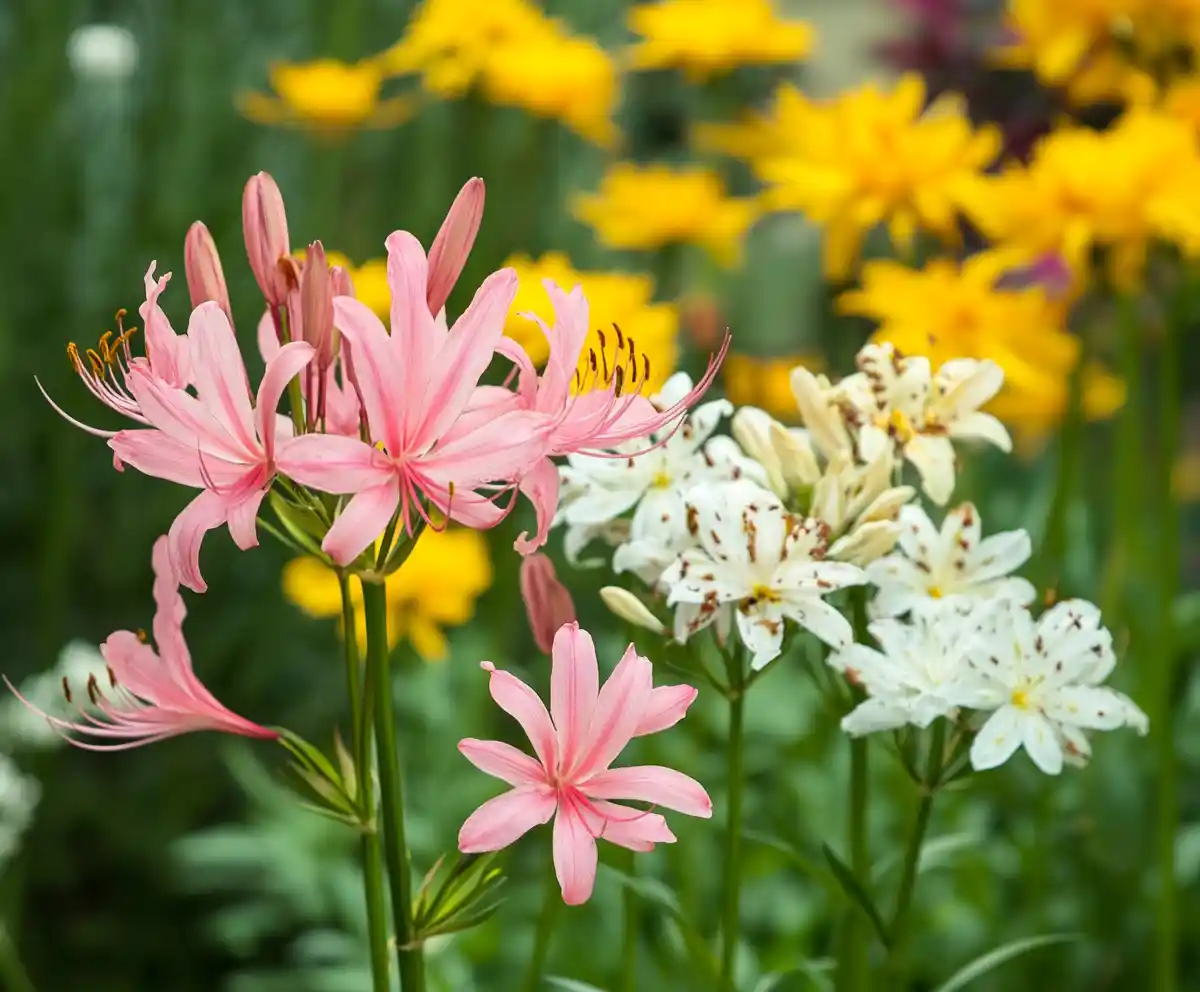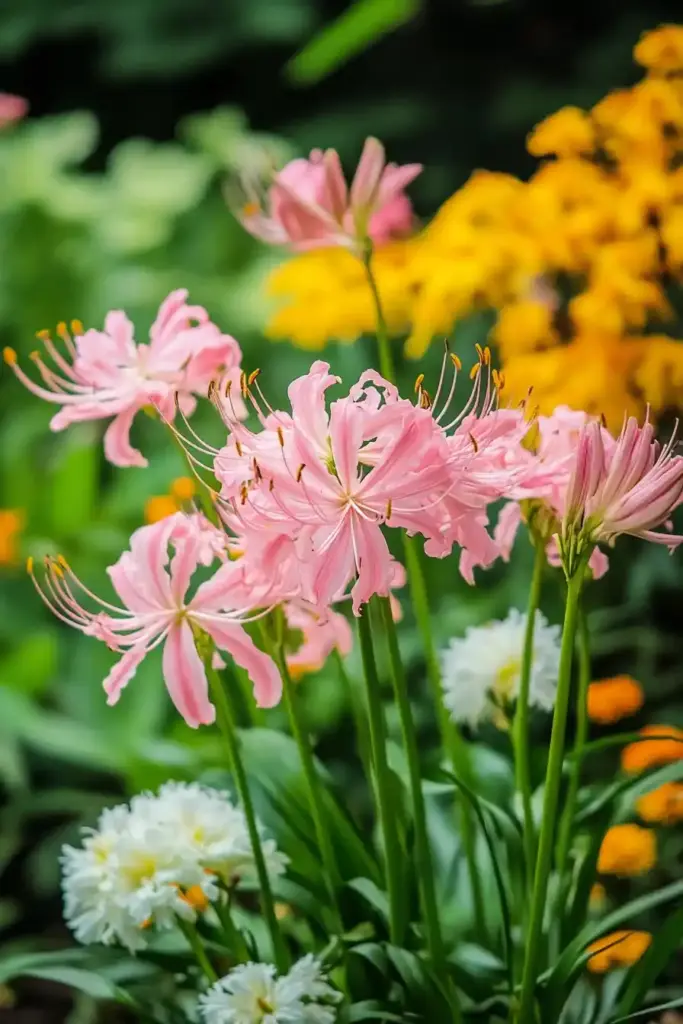Spider lilies (Lycoris spp.) are enchanting bulbs known for their striking, spider-like blooms that unfurl from bare stems in late summer and fall. These unique flowers often appear seemingly overnight, creating a dramatic garden surprise—hence nicknames like “naked lady,” “surprise lily,” and “hurricane lily.”
Native to parts of Asia, some varieties—such as Lycoris radiata—have naturalized in the southeastern United States, thriving in warm, temperate climates. These bulbs are beloved for their ability to bloom when most other plants are beginning to fade, adding bold color and intrigue to late-season gardens.
⚠️ Important Note: All parts of the spider lily are toxic to people and pets. Be cautious when planting in areas accessible to children or animals.
Table of Contents
Spider Lily Overview
Spider lilies belong to the Lycoris genus and are grown from bulbs that offer vibrant, spidery blooms in a range of hues. These perennials are often used to brighten up borders, cottage gardens, and naturalized spaces with minimal care once established.
Here’s a quick snapshot of what makes spider lilies garden-worthy:
- Botanical Name: Lycoris
- Common Names: Spider lily, surprise lily, naked lady, hurricane lily
- Plant Type: Bulb
- Light Requirements: Partial sun to full sun
- Mature Size: 1–3 feet tall, 1–2 feet wide
- Flower Colors: Red, pink, white, yellow, orange
- Foliage: Blue-green strap-like leaves (appear in spring, die back before blooming)
- Bloom Time: Late summer to early fall
- Hardiness Zones: USDA 5–10 (varies by species)
- Special Features:
- Deer and rodent resistant
- Attracts birds
- Excellent for cut flowers
- Forms naturalized colonies over time
- Propagation: Division of bulbs
Spider lilies are a low-maintenance addition to the garden with the bonus of long-lasting blooms and strong visual appeal. Their unusual blooming pattern—flowers first, foliage later—makes them an especially intriguing choice for gardeners looking to add seasonal drama.
Where to Plant Spider Lily
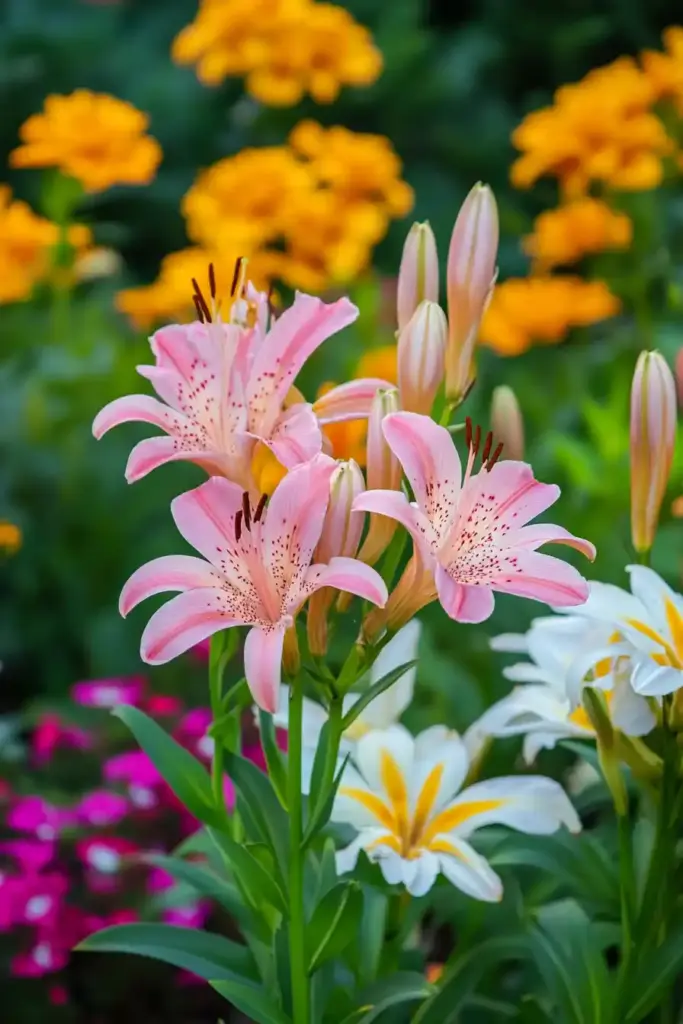
To help spider lilies thrive, selecting the right location is key. These bulbs prefer well-drained soil and a partially sunny to sunny site. While adaptable to different soil pH levels—acidic, neutral, or alkaline—the soil should never be soggy, especially during their dormant phase.
Here are some ideal spots to plant spider lilies:
- 🌿 Garden Borders: Add dramatic late-season color to perennial beds.
- 🌼 Cottage Gardens: Perfectly suited for informal, flower-rich designs.
- 🪴 Patio Edges: Plant near walkways or patios where their surprise blooms can be easily admired.
- 🌳 Naturalized Areas: Allow bulbs to multiply freely under deciduous trees or open woodlands.
- 🌱 With Ground Covers: Since spider lily foliage disappears by midsummer, pair them with low-growing, slow-spreading ground covers to maintain visual interest and fill the space.
📌 Pro Tip: Spider lilies don’t like to be disturbed. Choose a spot where they can settle and form colonies over time without needing frequent digging or division.
How and When to Plant Spider Lily
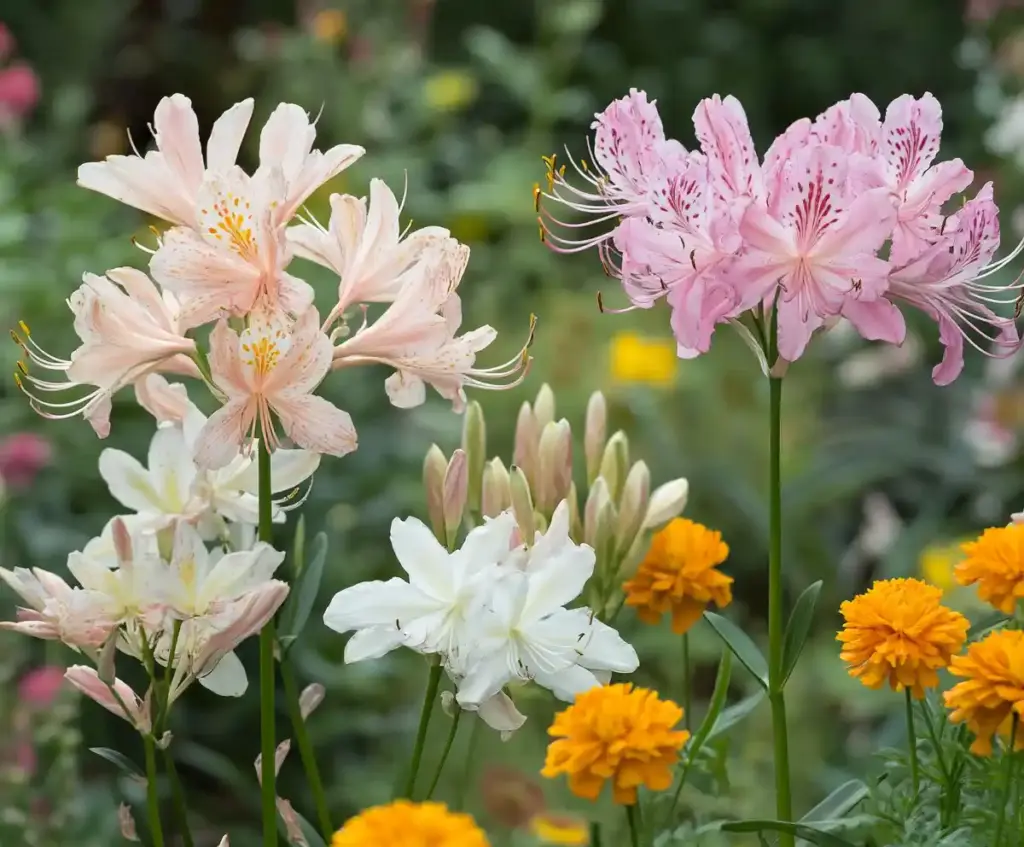
Spider lilies are best planted in early fall, giving them ample time to settle in before winter dormancy. These bulbs are unlike most—they prefer to sit shallow in the soil, and if planted too deep, they may not bloom.
🌱 Planting Guidelines:
- Timing: Early fall, ideally before the first frost.
- Depth: Position bulbs so their necks are just below or slightly above the soil surface—no more than ¼ inch deep.
- Spacing:
- Lycoris radiata (red spider lily): 6–12 inches apart
- Lycoris squamigera (naked lady): around 6 inches apart
💡 Tips for Success:
- Prepare the soil by loosening it and mixing in organic matter if needed to improve drainage.
- Water the bulbs lightly after planting.
- Mark their location—since they may not bloom the first year, it’s easy to forget where they’re planted!
Planting spider lilies correctly from the start sets the stage for vibrant, surprise blooms in seasons to come.
Spider Lily Care Tips
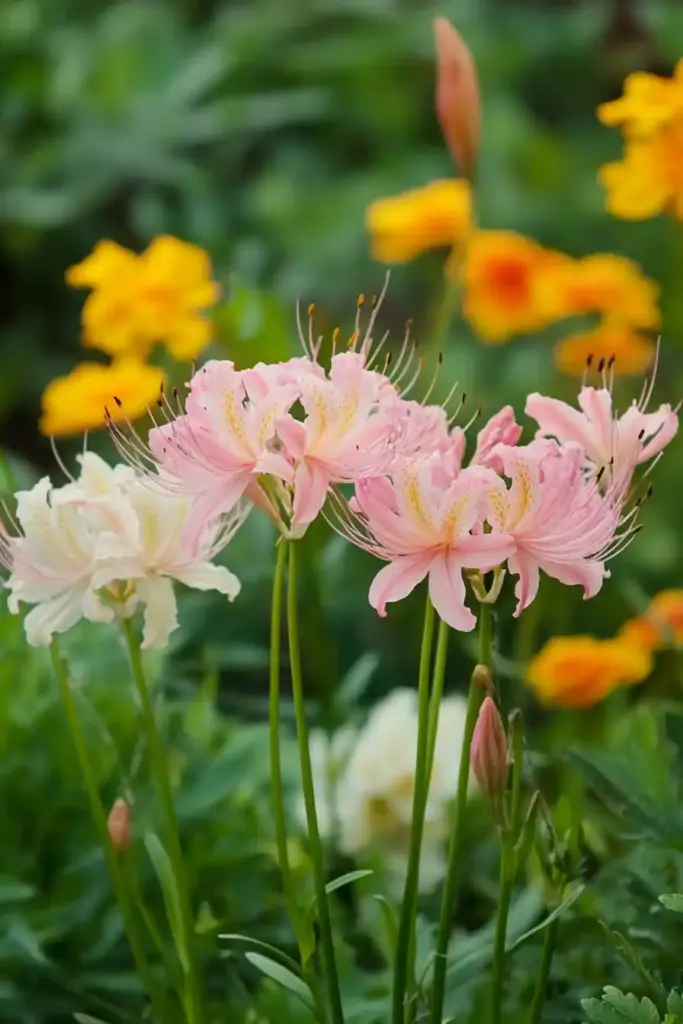
Once established, spider lilies are remarkably low-maintenance, making them a favorite among both novice and seasoned gardeners. To keep them healthy and blooming year after year, follow these essential care guidelines:
☀️ Light Requirements
- Thrives in full sun to partial shade.
- Partial shade often promotes the best flowering, especially in warmer climates where some midday protection helps.
🌱 Soil and Water
- Prefers well-drained soil; spider lilies are prone to root rot in soggy conditions.
- Soil pH can range from slightly acidic to alkaline (6.0–8.0).
- Keep soil moist during the growing season (spring foliage phase).
- Allow soil to dry out during dormancy (summer and winter), mimicking natural cycles.
🌡️ Temperature and Humidity
- Lycoris squamigera is the hardiest, tolerating USDA Zone 5.
- Lycoris radiata is better suited for Zones 7–10 and may need protection from harsh winter cold in borderline areas.
- Tolerates high humidity well—ideal for southeastern U.S. climates.
🌿 Fertilizer Routine
- Spring: Use a high-nitrogen fertilizer to support healthy foliage and energy storage.
- Post-bloom (late summer/fall): Switch to a low-nitrogen, high-phosphorus fertilizer to strengthen roots and prepare for next season.
✂️ Pruning
- Avoid cutting back healthy foliage—it’s essential for storing energy in the bulbs.
- Only remove dead or diseased leaves after winter or once they’ve naturally yellowed and withered.
🚫 Potting Note
- Not recommended for containers. Their deep root systems and sensitivity to freeze-thaw cycles make ground planting a better long-term choice.
Pests and Problems
One of the many reasons gardeners love spider lilies is their resilience. These bulbs are largely pest- and disease-free, requiring little intervention throughout the year.
🐌 Common Issues (or Lack Thereof)
- Pests:
- Deer and rodents avoid spider lilies thanks to their toxicity.
- Insects rarely bother them—making these bulbs a stress-free choice in wildlife-prone areas.
- Diseases:
- The main concern is root rot, typically caused by poor drainage or overwatering, especially during dormancy.
- To avoid issues, always plant in well-draining soil and let the bulbs dry out during summer.
📌 Preventive Tip: If you’re planting in clay-heavy or moisture-retentive soil, amend it with compost or coarse sand to improve drainage.
How to Propagate Spider Lily
Propagating spider lilies is an easy and rewarding way to expand your garden’s late-season color. These bulbs naturally multiply over time, but you can also divide them manually to speed up the process.
🌸 Propagation by Division
- Timing:
- The best time to divide is after the plants go dormant—typically early summer, once all the foliage has yellowed and died back.
- Steps to Divide:
- Gently dig up the clump of bulbs using a spade or garden fork.
- Carefully separate the bulbs by hand. Each should have roots attached.
- Replant immediately at the same shallow depth as new bulbs (neck slightly exposed or just below the surface).
- Water lightly to help settle them in.
⚡ Quick Tip: Division isn’t necessary every year—only when clumps become crowded or you want to create new plantings in other parts of your garden.
Types of Spider Lily
Several beautiful species and hybrids fall under the spider lily umbrella, offering gardeners a stunning palette of colors and forms. Here are a few popular types to consider:
🔥 Red Spider Lily (Lycoris radiata)
- Description: Loose clusters of vibrant red, spidery blooms that pop in early fall.
- Height: About 18 inches tall.
- Zones: Best suited for Zones 7–10.
- Special Note: This variety is the most widely recognized and often associated with hurricane season in the southeastern U.S.
🤍 White Spider Lily (Lycoris albiflora)
- Description: Elegant, white flowers with delicately curled petals, offering a fresh, luminous look.
- Height: Grows 18–24 inches tall.
- Zones: Thrives in Zones 8–10.
💗 Naked Lady (Lycoris squamigera)
- Description: Produces lush, strap-like spring foliage, followed by lilac-pink flowers in the fall.
- Height: Stands 18–24 inches tall.
- Zones: Exceptionally hardy, suitable for Zones 5–10.
🌸 Bonus: Across the many Lycoris species and hybrids, flower colors range widely—from peach, yellow, and coral to orange and even pink with blue-tipped petals.
FAQs About Spider Lily
❓ Do spider lilies naturalize easily?
Yes! Spider lilies are excellent naturalizers. Over the years, they multiply by producing bulb offsets, forming charming colonies that require minimal care. Once established, they can thrive and spread without much intervention.
❓ How long does it take spider lilies to bloom after planting?
Newly planted bulbs may take a couple of seasons to establish before producing blooms. It’s normal for spider lilies to focus on developing strong root systems before showing off their stunning flowers.
❓ Are there different colors available besides red?
Absolutely! While the red spider lily (Lycoris radiata) is the most famous, spider lilies also come in white, pink, yellow, peach, coral, and even pink with blue-tipped petals depending on the species and hybrids.
❓ Can spider lilies survive cold winters?
Some species, like Lycoris squamigera, are hardy down to Zone 5. However, more tender types like Lycoris radiata prefer Zones 7–10 and may need extra winter protection in colder climates.
Conclusion
Spider lilies bring an element of surprise and elegance to the garden with their bold, spidery blooms and fascinating growth habits. Whether you’re adding a splash of red to a cottage border or naturalizing a wooded area with pink and white varieties, these bulbs offer beauty with minimal fuss. Once planted in the right spot, spider lilies will reward you for years with their stunning, late-season displays—just when the garden needs a final burst of color.
🌱 Final Gardening Tip: Mark your planting spots—since spider lilies are late bloomers with disappearing foliage, it’s easy to forget where you placed them until they suddenly reappear!

